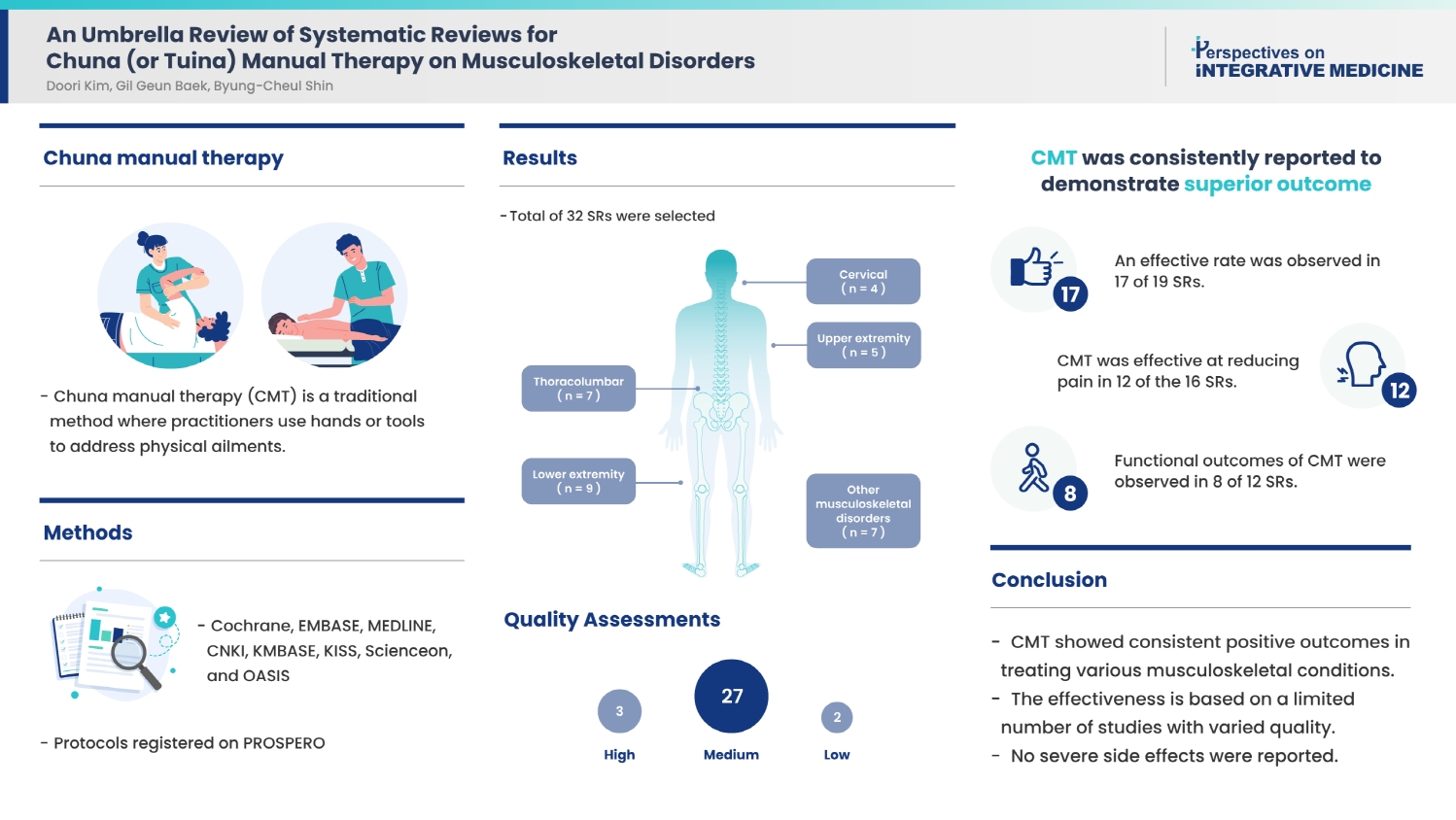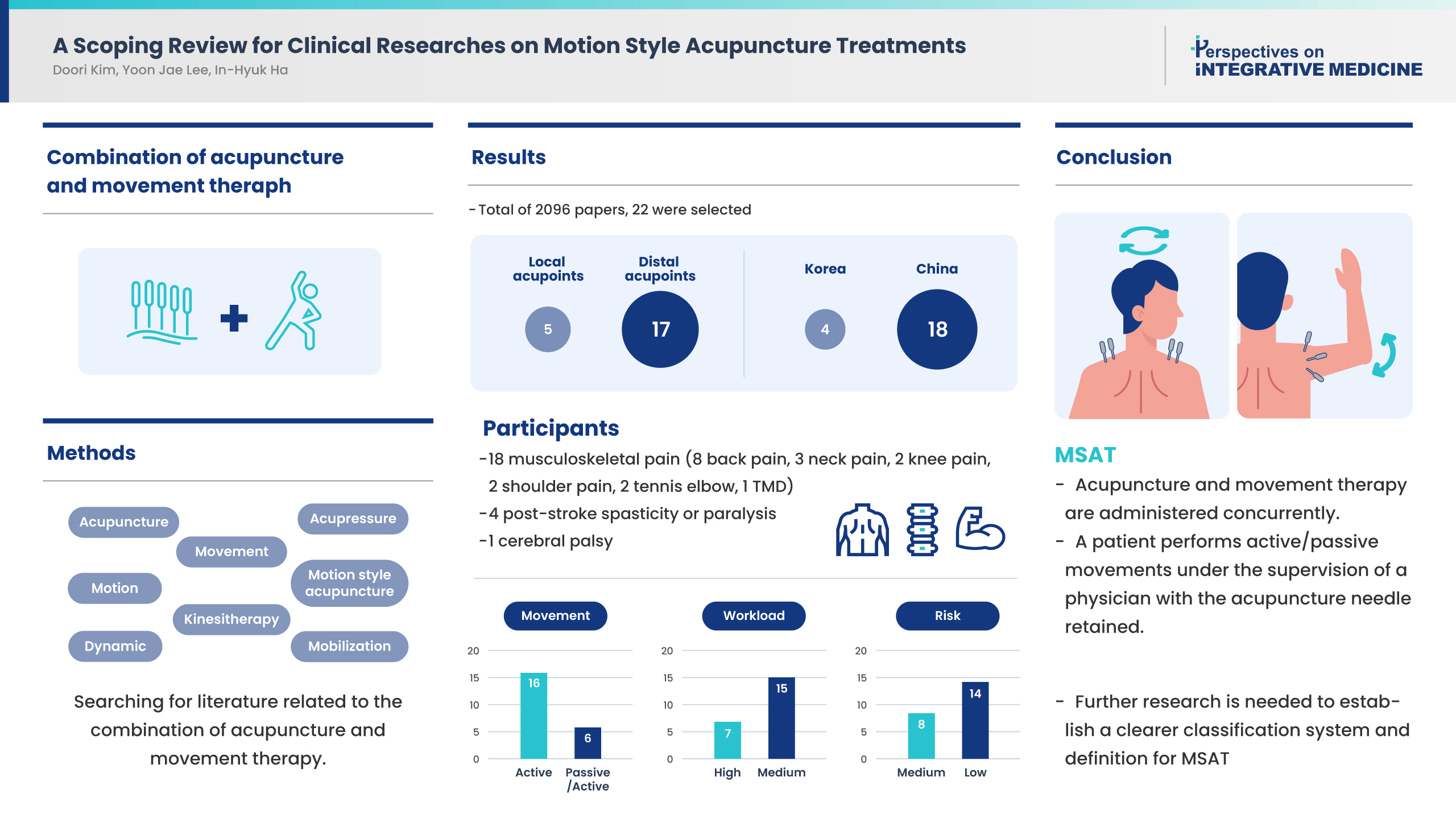Search
- Page Path
- HOME > Search
Review Articles
- An Umbrella Review of Systematic Reviews for Chuna (or Tuina) Manual Therapy on Musculoskeletal Disorders
- Doori Kim, Gil Geun Baek, Byung-Cheul Shin
- Perspect Integr Med. 2023;2(3):142-154. Published online October 23, 2023
- DOI: https://doi.org/10.56986/pim.2023.10.002
- 730 View
- 29 Download
-
 Graphical Abstract
Graphical Abstract
 Abstract
Abstract
 PDF
PDF Supplementary Material
Supplementary Material 
- Background
To provide clinicians with reliable evidence an umbrella review of systematic reviews (SRs) on Chuna manual therapy (CMT) for musculoskeletal disorders was performed to synthesize important outcomes.
Methods
There were eight databases (Cochrane, EMBASE, MEDLINE, CNKI, KMBASE, KISS, Scienceon, and OASIS) searched as well as the international database Prospective Register of Systematic Reviews in health and social care until August 2023. SRs of randomized controlled trials involving patients with musculoskeletal conditions, limited to interventions explicitly labeled as “Chuna” or “Tuina” in English, Chinese, or Korean language were retrieved. Two reviewers independently conducted selection and data extraction, and SR quality was assessed using A Measurement Tool to Assess Systematic Reviews tool (low, medium, or high quality).
Results
This review included 32 SRs, categorized by cervical (n = 4), thoracolumbar (n = 7), upper extremity (n = 5), lower extremity (n = 9), and other musculoskeletal disorders (n = 7). Quality assessments determined that three SRs were of “high” quality, two were “low” quality, and the remaining SRs were of “medium” quality. CMT was consistently reported to demonstrate superior outcomes: an effective rate was observed in 17 of 19 SRs, CMT was effective at reducing pain in 12 of the 16 SRs, and functional outcomes of CMT were observed in 8 of 12 SRs. No serious adverse events were reported.
Conclusion
CMT may be a safe and effective treatment for various musculoskeletal disorders based on the limited number of studies and the low quality of included SRs.
- A Scoping Review of Clinical Research on Motion Style Acupuncture Treatment
- Doori Kim, Yoon Jae Lee, In-Hyuk Ha
- Perspect Integr Med. 2023;2(2):65-76. Published online June 23, 2023
- DOI: https://doi.org/10.56986/pim.2023.06.001
- 1,365 View
- 39 Download
- 2 Citations
-
 Graphical Abstract
Graphical Abstract
 Abstract
Abstract
 PDF
PDF 
- This scoping review was conducted to examine the concept of Motion style acupuncture treatment (MSAT), use in clinical practice, its effectiveness, and safety. A literature review of clinical study treatment methods combining acupuncture and movement therapy was performed using PubMed. Of 2,096 studies retrieved, 22 were included in this review. There were 12 randomized controlled trials, and all 22 studies were published in China and Korea, mostly, within the last 3 years. There were five studies concerning local acupoints and 17 studies regarding needling at distal acupoints, and the level of risk of the procedure was “high” in eight studies and “moderate” in 14 studies. The study participants were patients with musculoskeletal pain, and many studies reported significant improvements in pain and functional disability outcomes following treatment using MSAT. For conclusion, MSAT refers to a treatment method in which a patient performs active/passive movements under the supervision of a physician with the acupuncture needle retained at the insertion site. However, there are a limited number of MSAT studies, and various treatment types and related terms are mixed. Further studies, classification of the types of MSAT using a well-established classification system, and a clearer definition of the MSAT concept are needed.
-
Citations
Citations to this article as recorded by- Effectiveness of lumbar motion style acupuncture treatment on inpatients with acute low back pain: A pragmatic, randomized controlled trial
Oh-Bin Kwon, Dong Wook Hwang, Dong-Hyeob Kang, Sang-Joon Yoo, Do-Hoon Lee, Minjin Kwon, Seon-Woo Jang, Hyun-Woo Cho, Sang Don Kim, Kyong Sun Park, Eun-San Kim, Yoon Jae Lee, Doori Kim, In-Hyuk Ha
Complementary Therapies in Medicine.2024; 82: 103035. CrossRef - Effectiveness and Safety of Progressive Loading–Motion Style Acupuncture Treatment for Acute Low Back Pain after Traffic Accidents: A Randomized Controlled Trial
Seung-Yoon Hwangbo, Young-Jun Kim, Dong Guk Shin, Sang-Joon An, Hyunjin Choi, Yeonsun Lee, Yoon Jae Lee, Ju Yeon Kim, In-Hyuk Ha
Healthcare.2023; 11(22): 2939. CrossRef
- Effectiveness of lumbar motion style acupuncture treatment on inpatients with acute low back pain: A pragmatic, randomized controlled trial
Original Articles
- Current Status of Korean Medicine Treatment for Post-acute COVID-19 Syndrome: A Survey of Korean Medicine Doctors
- Doori Kim, Seo-Hyun Park, Won-Suk Sung, Eun-Jung Kim
- Perspect Integr Med. 2022;1(1):34-44. Published online September 22, 2022
- DOI: https://doi.org/10.56986/pim.2022.09.006
- 1,430 View
- 40 Download
-
 Abstract
Abstract
 PDF
PDF Supplementary Material
Supplementary Material - Background
The applicability of Korean medicine (KM) treatments for post-acute COVID-19 syndrome were investigated.
Methods
A cross-sectional, web-based survey of Korean medical doctors (KMDs) was conducted in June 2022. The 25-item questionnaire comprised of five parts: basic characteristics, prescribed post-COVID-19 KM treatments, treatment effect in patients with post-acute COVID-19 syndrome, patient satisfaction, and awareness and utilization of the relevant KM Clinical Practice Guideline by the KMDs.
Results
In total, 1,063 completed questionnaires were collected, and 822 were analyzed. The most common symptoms in patients with post-acute COVID-19 syndrome treated by KMDs was weakness and fatigue (84.3%). Herbal decoctions (39.2%) and herbal powder (not covered by medical insurance; 25.8%) were primarily used. Among the KMDs, 95% (n = 781) responded that KM treatments, particularly herbal decoctions (82.6%) and herbal powder (not covered by medical insurance; 46.8%), were effective. Overall, 92.6% (n = 761) of KMD participants answered that the patients were satisfied with KM treatments, mostly due to symptomatic improvement (60.8%). The primary reason for dissatisfaction was the burden of cost for patients (78.4%). The main reasons for low uptake of KM services by patients with post-acute COVID-19 syndrome were lack of publicity and administrative issues such as no health insurance coverage.
Conclusion
KM is highly applicable for post-acute COVID-19 syndrome. Health policies supporting the use of KM for post-acute COVID-19 syndrome are recommended.
- An Overview of Clinical Features, and Medical Access Among Patients with Post-Acute COVID-19 Syndromes: Analysis of a Nationwide Survey in Korea
- Doori Kim, Ui Min Jerng, Jee Young Lee
- Perspect Integr Med. 2022;1(1):21-33. Published online September 22, 2022
- DOI: https://doi.org/10.56986/pim.2022.09.005
- 1,468 View
- 44 Download
-
 Abstract
Abstract
 PDF
PDF Supplementary Material
Supplementary Material - Background
The objective of this study was to identify the clinical features of patients who recovered from COVID-19, and to determine their unmet medical needs and quality of life.
Methods
A cross-sectional national survey was conducted in Korea in June 2022, targeting patients with at least four weeks of symptoms of COVID-19. The questionnaire survey had 37 items across: basic characteristics, acute COVID-19 and post-acute COVID-19 syndrome (long COVID) symptoms, access to medical facilities for long COVID, unmet medical needs, long COVID support system, and quality of life.
Results
Among 1,430 responses, 745 (52.1%) respondents had experienced long COVID. The most common symptoms were ear, nose, and throat complications (n = 461, 61.9%), followed by weakness and fatigue (n = 393, 52.8%). Amongst the 745 respondents who experienced long COVID, 337 (45.2%) had visited a medical institution, of which, 84.9% had visited a clinic or hospital for treatment. Korean medicine clinics and hospitals had the highest satisfaction rates (43.4%). There were 242 respondents (32.5%) who reported unmet medical needs for their long COVID. Symptom severity and duration of COVID-19 were risk factors for unmet medical needs. Quality of life was low in those patients with long COVID and unmet medical needs, and decreased further with increased severity and longer duration of symptoms.
Conclusion
Studies on the effects of Korean medicine treatment of long COVID, and establishing a system providing sufficient treatment for patients with long COVID are needed. These findings could be used by clinicians, researchers, and COVID-19-related policymakers.



 First
First Prev
Prev


